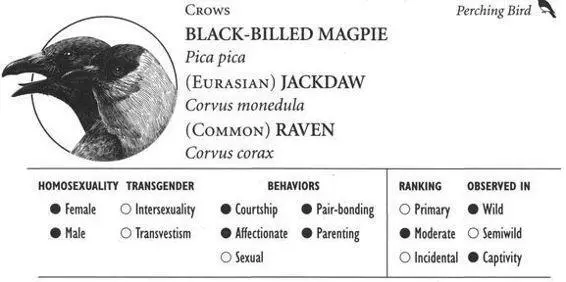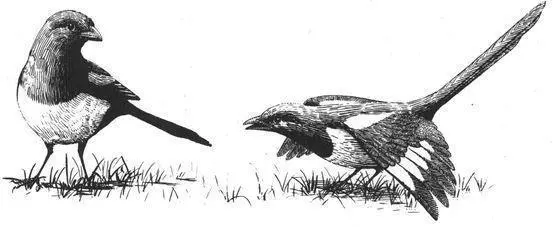———(1978/79) “Remarks Concerning the Social Behavior of Wattled Starlings, Creatophora cinerea (Menschen).” Journal of the Nepal Research Center 2/3:263—68.
Teather, K. L., and R. J. Robertson (1986) “Pair Bonds and Factors Influencing the Diversity of Mating Systems in Brown-headed Cowbirds.” Condor 88:63—69.
Uys, C. J. (1977) “Notes on Wattled Starlings in the Western Cape.” Bokmakierie 28:87—89.
Veiga, J. P. (1993) “Prospective Infanticide and Ovulation Retardation in Free-Living House Sparrows.” Animal Behavior 45:43—46.
———(1990) “Infanticide by Male and Female House Sparrows.” Animal Behavior 39:496-502.
Wetton, J. H., and D.T. Parkin (1991) “An Association Between Fertility and Cuckoldry in the House Sparrow, Passer domesticus .” Proceedings of the Royal Society of London, Series B 245:227-33.
Yokel, D. A. (1986) “Monogamy and Brood Parasitism: An Unlikely Pair.” Animal Behavior 34:1348—58.
Yokel, D. A., and S. I. Rothstein (1991) “The Basis for Female Choice in an Avian Brood Parasite.” Behavioral Ecology and Sociobiology 29:39—45.

BLACK-BILLED MAGPIE
IDENTIFICATION: A pigeon-sized, crowlike bird with striking iridescent, black-and-white plumage and a long, greenish purple tail. DISTRIBUTION: Eurasia, North Africa, western North America. HABITAT: Woodland, scrub, grassland, savanna. STUDY AREAS: Haren, the Netherlands; University of Groningen, the Netherlands; subspecies P.p. pica .
JACKDAW
IDENTIFICATION: A small crow with black plumage and gray on the back of the head. DISTRIBUTION: Eurasia, North Africa. HABITAT: Forest, grassland, farmland. STUDY AREAS: Haren, the Netherlands; Max-Planck Institute; subspecies C.m. spermologus .
RAVEN
IDENTIFICATION: A large (2 foot), all-black bird similar to a crow but much bulkier. DISTRIBUTION: Eurasia, North America. HABITAT: Varied, including forest, plains, desert. STUDY AREA: Max-Planck Institute; subspecies C.c. corax.
Social Organization
All three of these Crow species are quite gregarious, often associating in flocks and communal roosts. Individuals generally form long-term mated pairs, and Jackdaws usually nest in colonies. Magpies sometimes participate in remarkable group displays known as CEREMONIAL GATHERINGS, noisy aggregations that may be related to territory acquisition.
Description
Behavioral Expression: Black-billed Magpies sometimes court and form pair-bonds with birds of the same sex. Partners include adult males with younger or juvenile males (less than one year old), or else two females or two males of the same age, usually juveniles but also sometimes two adult males. A typical homosexual courtship—for example, between two males—begins with one bird ritually BEGGING the other by crouching in front of him and flapping or quivering his wings while uttering a begging call. The other male responds by hopping in tight circles around him, fluffing up his white feathers and flicking his wings; he may also BABBLE-SING, a varied combination of warbling, chattering, and yelping notes. The circling male often adopts a TILTING posture, in which he points his head and tail sideways toward the other male. If the male he is courting flies off, a courtship pursuit known as CHASE-HOPPING may develop, in which one male follows the other while alternately flying and hopping. Sometimes the two birds also HOVER-FLY, one in front of the other, using a rhythmic, undulating flight pattern. The same series of behaviors is seen in courtships between females (as well as in heterosexual interactions). Homosexual courtship sessions can last for up to half an hour. After courting, two birds of the same sex may form a pair-bond. Paired birds stay near each other, follow one another, and often cooperate in evicting intruders from their territory. They also frequently sit close together and preen one another or engage in mutual BILLING, in which they affectionately nibble at each other’s beak. Sometimes, homosexual mates also pull or nibble on the same leaf or twig and pass it back and forth between them; this is known as TUGGING. Same-sex pair-bonds are generally of shorter duration than adult heterosexual bonds and last from a few days to several months. However, adult males sometimes form longer-lasting homosexual pairs, and the two birds may even build a nest together (which typically takes five to seven weeks to construct).
Female Jackdaws occasionally develop pair-bonds with other females. In some cases, an older female pairs with a younger one, and the two build a nest together even though the juvenile bird is too young to lay eggs. Later, they might construct a unique “double nest” consisting of two adjacent cups and lay infertile eggs in both cups. Sometimes, a homosexual pair is joined by a male, who may bond with one or both of the females to form a bisexual trio; in this way, the females can lay fertilized eggs. However, they are often unable to successfully care for their offspring, precisely because their bond to each other means that they try to stay together all the time. The two females incubate their eggs and brood their youngsters simultaneously, each sitting on one cup. When the male arrives for his shift, however, they both depart together, leaving the male to try to cover and protect both sets of eggs or nestlings at the same time (which he is usually unable to do). Sometimes, a bi-sexual trio forms when a female joins a heterosexual pair and develops a strong bond with the female partner. The two females engage in courtship and pair-bonding activities such as mutual preening or COURTSHIP-FEEDING, in which one partner begs the other by crouching, fluttering her wings, and quivering her tail. Both females might mate with the male and lay fertile eggs, although the bond between them can end up being stronger than the original heterosexual bond. In fact, in one case the female partners were not able to properly care for their young because the male denied the female “interloper” access to the nestlings. Homosexual bonds also sometimes develop between widowed and nonbreeding females. In these cases, females that lose their male partners during the breeding season may attract unmated females to pair with them; some of these widows are mothers, while others have no offspring. Unlike bisexual trios, which may remain together for years, these female bonds appear to be more transitory, usually lasting only for several weeks until the breeding season is over.
Homosexual courtship in Black-billed Magpies: “tilting” ( left ) and “begging”

Female homosexual pairs also occasionally occur in Ravens, including incestuous bonds between yearling sisters. Birds in same-sex pairs engage in intense courtship activity similar to heterosexual pairs, such as mutual preening and courtship-feeding.
Frequency: Among Jackdaws in the wild, approximately 5 percent of trios include bonding between the two female partners, while about 10 percent of widowed females form homosexual pairs. Overall, though, same-sex bonds probably represent no more than 1 percent of all pairs/trios. Homosexual activity occurs sporadically in Black-billed Magpies and Ravens as well: about 1 percent of nesting pairs of Magpies, for example, consist of two males. Although homosexual copulations between Magpies have not yet been recorded, heterosexual matings are also infrequently observed (only 9 male-female copulations, for example, were recorded during one 300—hour study period).
Читать дальше














